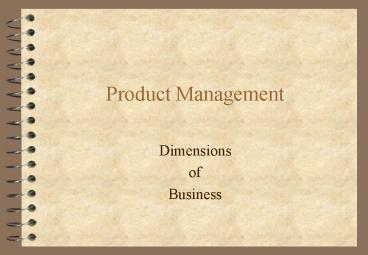Product Management PowerPoint PPT Presentation
1 / 34
Title: Product Management
1
Product Management
- Dimensions
- of
- Business
2
Why is this important?
- Engineering alone does not create wealth
- Beneficial change is achieved through
- Organisation, direction and coordination
- of People and resources
- one of which is Engineering.
3
Key Ingredients
- Engineering
- Marketing
- Management
- Money
- Sometimes Methodology is used for Engineering,
making the 4 Ms
Engineering
Marketing
Enterprise
Management
Money
4
Start-up business success
- Some great successes
- Success rate is low
- Keys-
- Value for customer
- Dont run out of money
5
Engineering
- Creative
- Mathematical and numerical basis
- Working with natural laws
- Elegance of science and engineering solutions
- See engineering in product
- Impatience with people problems
6
Marketing
- Creative
- Customer needs basis
- Work with social laws
- People and relationships are key
- Market behaviour is key
7
Management
- Creativity not key
- Goal driven
- Profitability
- Timing, efficiency, deadlines
- People and relationships
- Smooth running
8
Finance
- Money is key
- Accountability, Tracking, Control
- Budgets and their application
- Cash Flow
- Financial control and targets
- Payback on investments
9
Potential Conflicts
- Engineering factors vs customer perception
- Marketing idea of a New Product
- Budget categories seen as inflexible
- Deadlines vs Engineering rightness
10
Role of Engineering
- Technology seed bed
- Concepts Þ Products
- Engineering planning
- Technical liaison
- Documentation
11
Technology Resource
- Repository of Corporate Technical Know-how
- Develop appropriate technical skills
- Develop know-how on applications
- Keep up with technical developments
- Develop new areas of useful expertise
12
Concepts to Products
- System Thinking
- Specification
- Function ilities
- Product Design
- Available materials and processes
- Test and Evaluation
13
Engineering Planning
- Product Development Schedule and Budget
- Resource requirements people and facilities
- Skills coordination
- Configuration management
14
Technical Liaison
- Sub-contractors
- Production engineering and manufacturing
- Quality control
- Service, Support, Spares
- Other company activities
- Serve in Integrated Product Teams (IPT)
15
Documentation
- Engineering Data Control
- Manuals
- QC data
- Engineering reports
The jobs not finished until the paper-work is
done!!
16
Role of Marketing
- Market Intelligence
- Creativity
- Strategic Planning
- Promotion
- Sales Strategies
17
Market Intelligence
- Identify and study customers
- Psychology, Wants, Preferences
- Demography, Spending pattern, Motivation
- Marketplace awareness
- New Technology awareness
- Understand competitors
- Contacts network
- Seek power and influence
18
Market Creativity
- New ways to present products
- New products
- Market developments (eg lifestyle)
19
Strategic Planning
- Plan market placement
- Plan development to achieve plan
- Long-term planning and positioning
- Market niche recognition
- Countering competition
20
Promotion
- Advertising image and methodology
- Public relations
- Company image development
21
Sales strategies
- Overall strategies
- Effect of strategies on product
22
Role of Management
- Planning
- Resourcing
- Co-ordination
- Control
- Reporting
- Management is the art of getting things done.
23
Management Planning
- Strategic, for company growth
- Structure supporting long-term goals
- Logistic support for day-to-day
- Production, sales and distribution
- Fail to plan plan to fail
24
Resourcing
- Personnel Management
- Training and skills development
- Supply and support of equipment
- Manufacturing facilities
- Scheduling
- Manufacturing
- Purchasing
- Distribution
25
Control
- Monitoring progress of plans
- Resource application
- Trouble shooting
- Comparing forecasts with actual, and acting
26
Reporting
- Reports to Shareholders
- Taxation reports
- Government regulatory reports
- Internal management reports
27
Role of Finance
- Ensure river of cash never runs dry.
- Financial planning.
- Financial reports.
- Cash receipts.
- Cash payments.
28
Financial planning
- Arranging for cash as needed
- For short term activities
- For long term activities
- Budgets
- Major credit requirements
- Liaison with lenders
29
Financial reports
- Accounts (PL, Balance Sheet etc)
- Taxation
- Management reports
- Merger and T.O. analysis
- Efficiency analysis
30
Cash control
- Cash receipts
- Debtor control
- Cash payments
- Wages and salaries
- Creditors
- Major outlays
- Dividends
- Taxation and government charges
31
Large vs Small Enterprises
- Majority of businesses are small
- SMEs employ the majority of people
- Treatment of subject appears to imply size, but
same things must be done, large or small
32
Comparison
- Large Enterprise
- Many narrow specialists
- Slow to move and react
- Very large resources
- Large market strength
- Large influence
- Innovation difficult
- Financial mass and momentum
- Small Enterprise
- Few people, generalists
- fast reacting
- Small resources
- Brain power is company power
- Innovation easier
- Low financial mass
33
So...
- Management activities same
- Management styles different
- Management spread over different numbers of people
34
Tutorial
- Integrated Product Teams (IPTs) are becoming
increasingly used to coordinate the four
dimensions of the business in implementing
business activities. - Discuss the issues including-
- What IPTs are intended to achieve
- What skills should be represented
- Benefits and pitfalls

